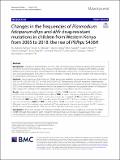Changes in the frequencies of Plasmodium falciparum dhps and dhfr drug-resistant mutations in children from Western Kenya from 2005 to 2018: the rise of Pfdhps S436H

View/
Publication Date
2020Author
M. Andreína Pacheco1, Kristan A. Schneider2 , Qiuying Cheng3 , Elly O. Munde4,5, Caroline Ndege4,6, Clinton Onyango4,6, Evans Raballah4,7, Samuel B. Anyona4,8, Collins Ouma4,6, Douglas J. Perkins3,4* and Ananias A. Escalante1*
Metadata
Show full item recordAbstract/
Background: Sulfadoxine-pyrimethamine (SP) is the only anti-malarial drug formulation approved for intermittent
preventive treatment in pregnancy (IPTp). However, mutations in the Plasmodium falciparum dhfr (Pfdhfr) and dhps
(Pfdhps) genes confer resistance to pyrimethamine and sulfadoxine, respectively. Here, the frequencies of SP resistance-associated mutations from 2005 to 2018 were compared in samples from Kenyan children with malaria residing
in a holoendemic transmission region.
Methods: Partial sequences of the Pfdhfr and Pfdhps genes were amplifed and sequenced from samples collected in
2005 (n=81), 2010 (n=95), 2017 (n=43), and 2018 (n=55). The frequency of known mutations conferring resistance to pyrimethamine and sulfadoxine were estimated and compared. Since artemisinin-based combination therapy
(ACT) is the current frst-line treatment for malaria, the presence of mutations in the propeller domain of P. falciparum
kelch13 gene (Pfk13) linked to ACT-delayed parasite clearance was studied in the 2017/18 samples.
Results: Among other changes, the point mutation of Pfdhps S436H increased in frequency from undetectable
in 2005 to 28% in 2017/18. Triple Pfdhfr mutant allele (CIRNI) increased in frequency from 84% in 2005 to 95% in
2017/18, while the frequency of Pfdhfr double mutant alleles declined (allele CICNI from 29% in 2005 to 6% in
2017/18, and CNRNI from 9% in 2005 to undetectable in 2010 and 2017/18). Thus, a multilocus Pfdhfr/Pfdhps genotype with six mutations (HGEAA/CIRNI), including Pfdhps S436H, increased in frequency from 2010 to 2017/18.
Although none of the mutations associated with ACT-delayed parasite clearance was observed, the Pfk13 mutation
A578S, the most widespread Pfk13 SNP found in Africa, was detected in low frequency (2.04%).
Conclusions: There were changes in SP resistance mutant allele frequencies, including an increase in the Pfdhps
S436H. Although these patterns seem consistent with directional selection due to drug pressure, there is a lack
of information to determine the actual cause of such changes. These results suggest incorporating molecular
Collections
Related items
Showing items related by title, author, creator and subject.
-
Sorghum is an important staple food crop in Kenya, but its yield is low due to many constraints which include diseases, drought, soil fertility, and pests, notably parasitic weed Striga hermonthica. Twenty elite sorghum genotypes and one resistant check were evaluated in three replications in a complete randomized design in Agar Gel (AG) experiment and randomized complete block design on selected Striga hotspot farms at Kadel and Nyahera in western Kenya. Significant differences (p<0.001) were realized both in the fields (plant height, dry shoot biomass yield, grain yield, field Striga count, and Striga damage ratings) and in the AG experiment with respect to maximum germination distance and numbers of induced germinated Striga seeds. Among the sorghum genotypes evaluated under field conditions, T53B, N57, N68, C26, IESV 92036-SH, T30B, and Uyoma 47 White genotypes had stable yields under Striga infestation in the two sites, whereas Nyadundo 1, Nyadundo 2, and Uyoma 8 were susceptible. In the AG experiment, E117B, T30B, Uyoma 8, Uyoma 42 STR, and T53B induced high numbers of germinated Striga seeds with maximum germination distances (MGD). In contrast, Uyoma 47 Brown, IESV 92038/2-SH, and IESV 92036-SH sorghum genotypes secreted low amounts of SLS suggesting resistance. This study has identified and selected four Striga tolerant (T53B, N68, N57, and T 30B) and resistant (C 26, Uyoma 47 Brown, IESV 92038/2-SH, and IESV 92036- SH) sorghum genotypes which can be utilized in further research programs or adopted to improve sorghum productivity in the highly Striga infested regions of western Kenya.
Ochiel, D. C. M. M. Dida, E. Ouma, P. A. Olweny, S. Gudu (Academic Journals, 2021)Sorghum is an important staple food crop in Kenya, but its yield is low due to many constraints which include diseases, drought, soil fertility, and pests, notably parasitic weed Striga hermonthica. Twenty elite sorghum ... -
Identification of Maize (Zea Mays L.) Genotypes Resistant to Striga Hermonthica (Del.) and Determination of Genetic Basis for Resistance
Mbogo, Peter Okoth (Maseno University, 2017)The obligate root hemi-parasite, Striga hermonthica (Del.) Benth., native to sub-Saharan Africa causes serious economic constraint to cereal production. There has been limited study to understand the genetics of Striga ... -
Non-host resistance to the finger millet blast pathogen Magnaporthe oryzae is modulated by a resistance response to PWL1 and PWL2 in Eragrostis curvula but not in related Chloridoid species
Hosea Isanda Masaki, Santie de Villiers, Peng Qi, Kathryn Prado, Davies Kiambi Kaimenyi, Kassahun Tesfaye, Tesfaye Alemu, John Takan, Mathews Dida, Justin Ringo, Wilton Mbinda, Chang Hyun Khang, Katrien Devos (2023-05-28)Magnaporthe oryzae, a devastating pathogen of finger millet (Eleusine coracana), secretes effector molecules during infection to manipulate host immunity. This study determined the presence of avirulence effector genes ...
